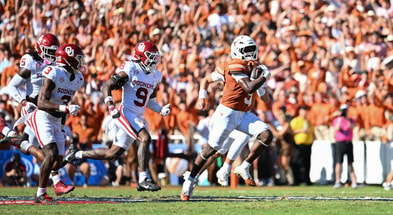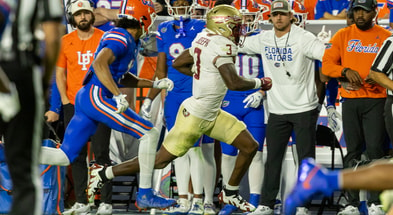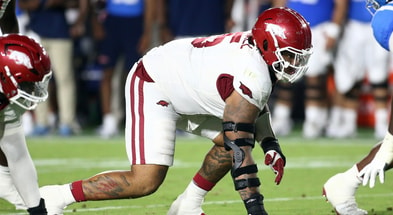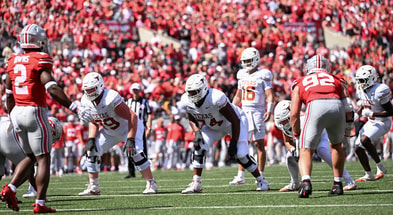The SEC is going to raise the volume on the Texas Longhorns
Inside Texas’ Paul Wadlington recently penned a piece that explained why the Longhorns will no longer be the biggest fixture on the schedule for most of their Southeastern Conference opponents.
[Join Inside Texas and get ONE MONTH of Longhorn intel for just $1!]
Wadlington’s overall point was that Texas was the top target for members of the newfangled Big 12, whether former Southwest Conference rival TCU or Johnny-come-lately West Virginia. The Longhorns were treated with an onslaught of Horns down and vitriol from fan bases and teams that focused as much on beating Texas as they did on beating real rivals. See Iowa State offensive lineman Jarrod Hufford proclaiming that he wanted to beat the Longhorns just as bad as he wanted to beat natural in-state rival Iowa for evidence.
While Texas is sure to see Horns down while playing on its inaugural 2024 schedule, and be victim of the new opponent novelty Wadlington mentioned, they won’t be the No. 1 target of every team they play going forward as members of the SEC. That said, the Longhorns shouldn’t confuse that for ease when traveling to new destinations, especially when it comes to the imposing road environments found within the conference.
The average size of the stadia outside of Austin the Longhorns could play in as members of the SEC, substituting the Cotton Bowl for Gaylord Family-Oklahoma Memorial Stadium, is 80,707.
Six of the stadia the Longhorns could potentially play conference road games in have capacities above that 80,707 average. Those venues are Bryant-Denny Stadium in Tuscaloosa, Ala., Kyle Field in College Station, Neyland Stadium in Knoxville, Tenn., Jordan-Hare Stadium in Auburn, Ala., Sanford Stadium in Athens, Ga., Ben Hill Griffin Stadium in Gainesville, Fla., and Tiger Stadium in Baton Rouge, La.
Additionally, the Cotton Bowl has a capacity of 92,100.
Though the Longhorns are unlikely to ever play in Norman, Okla., the home of the Sooners has a capacity of 80,126 but has held as many as 88,308.
That’s all to say, what Southeastern Conference teams may lack in Longhorn hatred they’ll surely make up in pure volume, both of the noise and people variety.
Take a look at the discrepancy between the average capacity of road venues on Texas’ 2024 slate compared to those in 2023. This season, the Longhorns will head to Dallas for their annual tilt with OU and also play at Vanderbilt, at Arkansas, and at Texas A&M. Even with a trip to the sleepy home of the Commodores, the smallest home venue in the SEC, the average capacity of the stadia for conference games away from Austin is 77,849.
In 2023, the average capacity of the stadia Texas played Big 12 away games in was 56,748. That includes the 92,100 of Cotton Bowl for the Red River Shootout, and even that stadium had over 45,000 Longhorn fans in attendance.
The contrast is illustrated again when looking at Texas’ 2022 schedule. With games at Texas Tech, at Oklahoma State, at Kansas, and at Kansas State, along with the 2022 Red River Shootout, the average capacity of the stadia Texas traveled to that season was 62,650.
Top 10
- 1New
Kewan Lacy
Rebels RB decides on future
- 2Hot
Nebraska QB dominoes
Huskers line up multiple visits
- 3
Kenny Minchey
Flips transfer commitment
- 4Trending
Portal Predictions
Predicting transfer commitments
- 5
Bryce Underwood
Decides on Michigan future
Get the Daily On3 Newsletter in your inbox every morning
By clicking "Subscribe to Newsletter", I agree to On3's Privacy Notice, Terms, and use of my personal information described therein.
On average, 15,000 more humans are going to see Steve Sarkisian‘s program when it leaves the friendly confines of Austin to play football in 2024 than in 2023.
This principle isn’t just limited to football.
The average capacity of the 13 men’s basketball venues outside of the Moody Center in the Big 12 is 12,273, led by the 19,000-person capacity of the Marriott Center which hosts the BYU Cougars. Nine road environments for the Longhorns in the current Big 12 boast five-figure capacities.
That number jumps to 13 of 15 when looking at the SEC, including Oklahoma in that 15. Only Auburn and Ole Miss are under 10,000. Plus, Kentucky and Tennessee boast indoor coliseums with capacities of over 20,000.
And in baseball? “It just means more” comes to life. The average capacity of the ballparks in the SEC (without factoring in UFCU Disch-Falk Field but including OU’s L. Dale Mitchell Park) is 7,160.
The Longhorns hosted 7,935 during a season-opening win over San Diego last week. That is the eighth largest crowd in the history of the Disch. The attendance figure from last Friday would rank 7th in the SEC as far as overall capacity. Consequently, athletics director Chris Del Conte has mentioned that the program is assessing ways to expand Disch-Falk Field outside of the Yeti Yard in left-center for when some of the premier programs in college baseball head to the east side of Interstate 35.
[Subscribe to the brand new Inside Texas YouTube channel!]
Will the Longhorns be the No. 1 focus of opposing teams in the SEC going forward? Aside from a couple of true regional rivals, that won’t be the case.
Will the noise level be a step above when looking at facility capacities for the three men’s major sports?
Undoubtedly.























